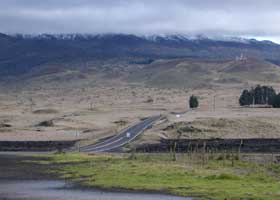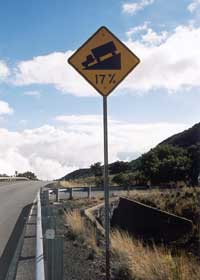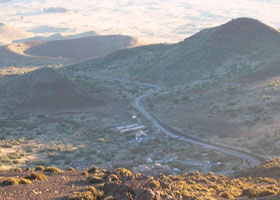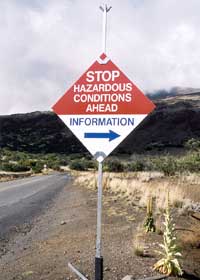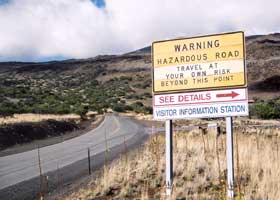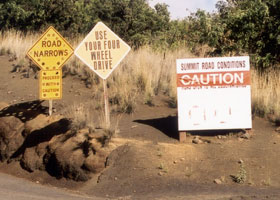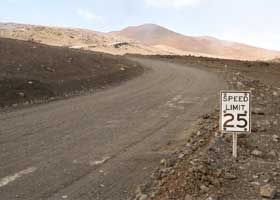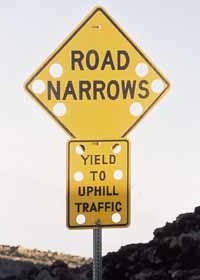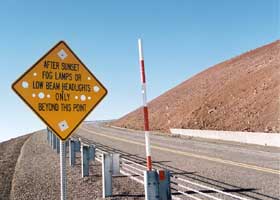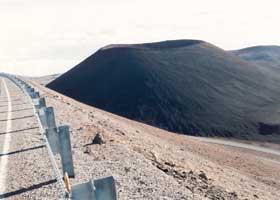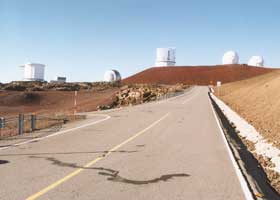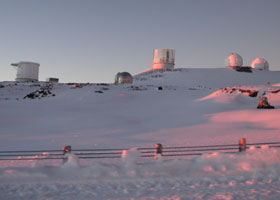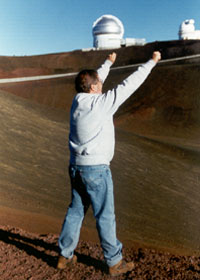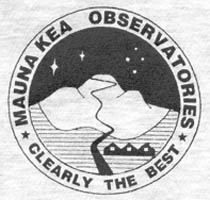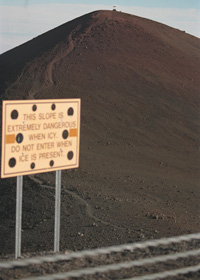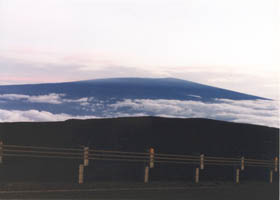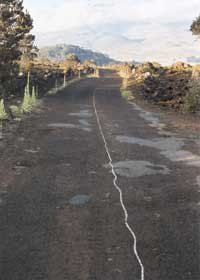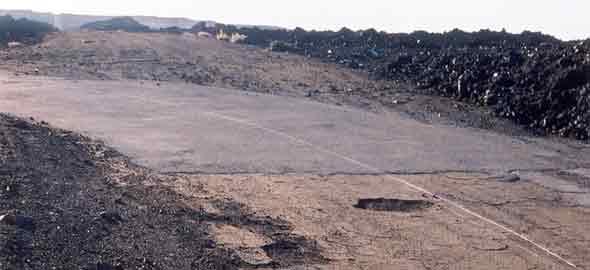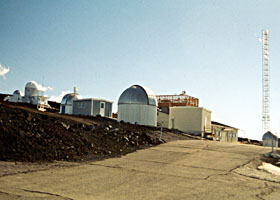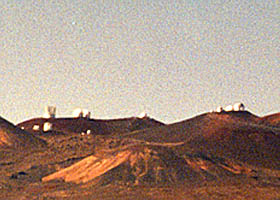| Hawaii Highways Road Photos --
Mauna Kea and Mauna Loa Observatories Roads (Big Island part 2 of 6 -- other Big Island parts: Saddle Road · Here are 22 photos of the ultra-high-altitude side roads branching from Saddle Road across Hawaii's Big Island, to the observatories atop Mauna Kea and on the north slope of Mauna Loa, Hawaii's two highest mountains. All the photos are my own, from my visits in October 1999 and November 2001, except four photos taken by Tim Reichard on his January 2005 visit to the Big Island. The road to the Mauna Kea summit, named John A. Burns Way (though more often just called "the Mauna Kea summit road"), is about 15 miles long. It branches north from Saddle Road, near mile 28. It is paved for the first six miles, to the Visitor Information Station of the Onizuka Center for International Astronomy, at about the 9300' level. Beyond there, the road becomes steep and unpaved for about five miles. The remaining four miles approaching the summit are paved, and not as steep. Just before the end, the road reaches its highest elevation at 13780', making it the third highest auto road in the United States, as well as the highest in Hawaii. From that point a short hike will take you to the Pu'u Wekiu summit at 13796', the highest point in Hawaii. The Mauna Kea summit area is extremely popular with astronomers worldwide, mainly for its clear and thin air, and minimal light pollution. The road to the weather observatory on the north slope of the Mauna Loa volcano is 17.1 miles long, branching south from Saddle Road 0.1 mile east of the turnoff for the Mauna Kea summit road. It is the second-highest road in Hawaii, a paved one-lane road with narrow shoulders passing through bleak lava fields. The weather observatory is operated by the National Oceanic and Atmospheric Administration, and conducts long-term monitoring of changes in the upper atmosphere. Also at road's end is one of the trailheads for a long and strenuous hike to the Mauna Loa summit. The U.S. Department of Transportation plans to resurface and otherwise improve the road, beginning in mid-2005. NOTE: In case you want more detail, clicking some of the photos below (for now, just some from my 2001 trip, and Tim Reichard's 2005 trip photos) will call up enlarged, higher-quality (less .jpg compression) versions. Those alternate versions have larger file sizes, so please be patient while they download. Warnings: Parts of Saddle Road, which you must travel to get to either of the observatories roads, are very narrow, with rough pavement edges, making head-on collisions a real problem. Dense fog, as moist air rising upslope from the coast meets cold air flowing downslope from Mauna Kea and Mauna Loa, can make for dangerously low visibility. The road west of the "saddle" is also not well reflectorized for night driving. Most rental car companies prohibit taking their vehicles on Saddle Road, or the observatories roads branching off from it (Harper's, in Hilo and Kailua-Kona, is a notable exception). Also, there are no travel services at all on Saddle Road or on the observatories roads. Make sure to refuel in Hilo before heading west, or Waimea, Waikoloa, or Kailua-Kona before heading east -- the high altitude can increase your fuel consumption quite a bit. The roads to the Mauna Kea and Mauna Loa observatories both take you above 11000'. The Mauna Loa road is paved but narrow, through jagged lava that can tear up your tires if you stray from the pavement -- which can be a task in poor visibility, since the road has little or no reflectorization, other than a thin fog line in the center of the pavement (see below -- all this may change, after the improvements planned to begin in mid-2005). The Mauna Kea road includes a steep (15% grade) unpaved stretch that, beyond the visitor center at about 9300', is restricted to 4-wheel-drive vehicles, and also has other restrictions to protect visitors and astronomers' work at the summit's many observatories (including a recommendation to hang around the visitor center at least a half-hour, for people ascending from sea level to acclimate and reduce the risk of altitude sickness at the summit). The Mauna Kea road is sometimes closed by snow in the winter, and the Mauna Loa road occasionally gets snowbound as well. The Mauna Loa volcano is active, though not currently erupting. An eruption could close the Mauna Loa observatory road, or the Saddle Road access to the Mauna Kea summit road, though such closures are improbable (the most recent eruption, in 1984, did not close the Mauna Loa observatory, the road up to the observatory, or Saddle Road), and there will be plenty of advance warning in any case. The Mauna Loa volcano is closely watched by the Hawaii Volcano Observatory, whose web site will have current information on any signs of trouble. Mauna Kea summit road (John A. Burns Way) Some other sites: Institute for Astronomy (including Mauna Kea road and summit photos, visitor and tour information, and a map of John A. Burns Way) Mauna Loa weather observatory (includes a few road photos, and a map of the access road)
Go to the previous or next parts of the Hawaii Highways road photos collection:
Overview · Introduction · Interstate H-3 · Interstate H-1 · Other Freeways
or to other sections of the Hawaii Highways site: Comments, etc.? Please e-mail me. © 1999-2003, 2005 Oscar Voss. |
